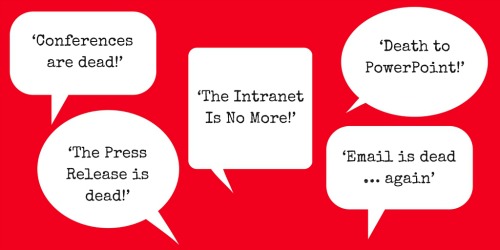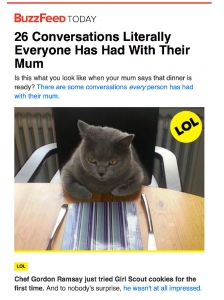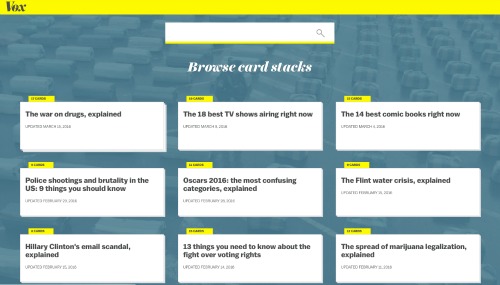Amazon recently announced the imminent opening of its second bricks-and-mortar bookstore.
The retail giant opened a 5,500 sq. foot bookstore in its hometown of Seattle last year, the new store is due to open in San Diego this summer, and plans are afoot for many more…
Despite the advancement of the eBook, there clearly remains a desire for the original paper alternative. The book continues to thrive in a world where shinier alternatives exist because that’s what people demand. They will always have their preferences.
But the stores aren’t just about books. Amazon has an opportunity to craft an entirely different experience for it’s customers. This is something that we should consider from a comms and engagement perspective. How can a particular channel or method add something special to the employee experience?
It’s natural to evolve and move forward but sometimes there remains a place for the trusted and established approaches.
Sensationalising the perceived demise of comms channels
 R.I.P. to email and death to the intranet!
R.I.P. to email and death to the intranet!
A few headlines that certainly grab our attention from time to time.
They’re not uncommon. We read them frequently; we hear the conversations, as we’re encouraged to believe that certain comms channels have had their day.
Are you a channel basher?
Do you jump on the bandwagons exaggerating the demise of channels? Are you always looking for the next shiny comms tool? Or perhaps you’re surrounded by others who get seduced by comms bling…
Defining the channel
A channel is simply an empty vessel waiting to be filled with crafted content and stories created with specific groups of people in mind.
Consider these dictionary definitions:
- A route through which anything passes or progresses
- Channels, the specific, prescribed, or official course or means of communication
‘Anything passes’ is certainly true – far too much people might say, but does it actually achieve progress? Does it connect and mean something to employees?
The second definition might well be true but sounds incredibly dull.
Our comms channels should be vibrant and alive with content and conversations. This is in the hands of us all to play our part.
Fix it, don’t ditch it
There are some channels that get their fair share of battering. Conferences and meetings for example, the intranet is often cited as extinct, email, the printed magazine and poor old PowerPoint – without a doubt. All of these suffer from the regular onslaught and hammering.
In some cases, the points are justified, perhaps it’s right to move on to different platforms. But often the argument has another side. Is the channel actually working? If not, why not? Is it being poorly managed or used incorrectly? Is the content suitable? Can it be developed to serve its purpose more effectively before being committed to the comms graveyard? Square pegs in round holes have never worked and they’re not likely to anytime soon.
Maintaining the mix
In reality, it’s all about the mix. Being open to new tools and platforms, reflecting technological advancements and developments in the outside world, understanding their capabilities and the benefits they can bring, and knowing how to apply them. But remaining faithful isn’t a sin and those trusted channels that have served us well can continue to do so.
Comms teams wrestle with these dilemmas all the time. No one organisation is the same and channels will differ from one place to the next. But it’s always worth taking a step back and reviewing the situation to check whether a refresh, rather than a complete channel overhaul is actually what’s required.
Undertake a channel audit
It’s important not to jump from one channel to the next without doing an audit to understand what is or isn’t working. This should include a deep dive into your audience types, exploring their preferences, how and when they like to consume messages, and to get insight into what they think about existing formats. Are there barriers to accessing your current comms channels? Can they be viewed any time, any place? Are you measuring results? Remembering always that the purpose of your audit is to check how effectively your channels are performing against your strategic objectives.
Commonly battered comms channels
 Take the all-staff email newsletter. If it’s not working, why not? Is it frequency or lack of interaction? Try freshening up the content, a redesign or encouraging more user-generated items like short people stories, blogs, interviews, team photos and videos. Perhaps sending it at different times – Friday morning is a popular choice. Or ditch the ‘weekly’ element and wait until there’s enough strong content. Segmenting the audience and sending more targeted content can have a huge impact and including embedded interactive features like pop quizzes can help to encourage engagement.
Take the all-staff email newsletter. If it’s not working, why not? Is it frequency or lack of interaction? Try freshening up the content, a redesign or encouraging more user-generated items like short people stories, blogs, interviews, team photos and videos. Perhaps sending it at different times – Friday morning is a popular choice. Or ditch the ‘weekly’ element and wait until there’s enough strong content. Segmenting the audience and sending more targeted content can have a huge impact and including embedded interactive features like pop quizzes can help to encourage engagement.
If email newsletters aren’t working for you, think about what grabs your attention outside of the office. Look out for those emails that make you sit up and take notice – what can be learnt from them? Perhaps BuzzFeed’s ‘10 things you need to know’ approach might work?
Your email newsletter should be a gateway to further content so flag headlines and teasers that link to other channels like the intranet.
 Talking of the intranet, according to VMA Group’s Inside Insight 2016 report, it’sthe most commonly utilised IC channel with 91% of businesses using one. Perhaps before deciding that the intranet is old news, focus on listening and responding to user needs and taking a more flexible mindset to your current issues. One of the biggest challenges shared universally is structure. Not from a technical perspective but how people access the content that they want as opposed to the content that others want them to see. Ideally these two priorities should be the same.
Talking of the intranet, according to VMA Group’s Inside Insight 2016 report, it’sthe most commonly utilised IC channel with 91% of businesses using one. Perhaps before deciding that the intranet is old news, focus on listening and responding to user needs and taking a more flexible mindset to your current issues. One of the biggest challenges shared universally is structure. Not from a technical perspective but how people access the content that they want as opposed to the content that others want them to see. Ideally these two priorities should be the same.
Consider how content is presented. We take inspiration from sources like Vox. It’s visual, it explains things clearly and it makes accessing news and information super easy. These card stacks are a particular favourite.
Don’t under-estimate your intranet’s power as a unifier and the value that employees place in being able to rely on that single source of information they need.
Conferences too get sent to the scrap heap. But we’ve come across many examples where a fresh new format has transformed the standard, mundane event into a roaring success. Make them experiential, involve your audience in workshops and interactive sessions. Try an unconference or a TED style presentation, bring people together in a memorable way, theme your day – we loved this example of an internal festival run by West Kent Housing Association.
As face-to-face communication continues to rein supreme, perhaps we shouldn’t be so quick to sack off such events. With some simple adjustments you can develop some truly special moments for employees.
The printed employee magazine, another classic casualty – but in our experience, the love hasn’t been lost. It’s surprising how much employees still value printed material. The ability to browse content and flick through stories in breaks or downtime makes a refreshing change from the onslaught of information we face. Take the opportunity to curate your stories and ensure that the narrative covers all aspects of your organisation’s personality. Quality publication and production can make employees feel that a real effort has been made – they feel valued. Extend that by asking them what they enjoy reading away from the office. Take a trip to the newsagents (they still exist). Buy some magazines; look at editorial styles and content. What are the possibilities for your publication?
In summary
As channels grow old they get tired. They need refreshing and revitalising. How can you breathe life into your channels, taking them by the scruff of the neck and doing something special with them?
Look for other benchmarks and inspiration from elsewhere like news updates, 60-second segments similar to TV channels or the creative ‘Pint-Sized Ashes’ series of animations used by the BBC to share the cricket updates?
When it comes down to it, it’s rarely about replacing one channel with another. It’s more about combining them to play to their strengths, letting employees choose what works best for them and rethinking how you deliver content rather than focusing too heavily on the mechanism.
Being interesting and relevant to your audiences is such an important element, not just the method used, and this can be overlooked when we’re under pressure to keep up with the next big thing in comms.
So stop and question how your channels are used before you kill them off. Because whilst we no longer pop to Blockbuster to rent a DVD, we can follow Amazon’s example by shaping the experiences of our audiences and evolving the channels that still have a place.
















